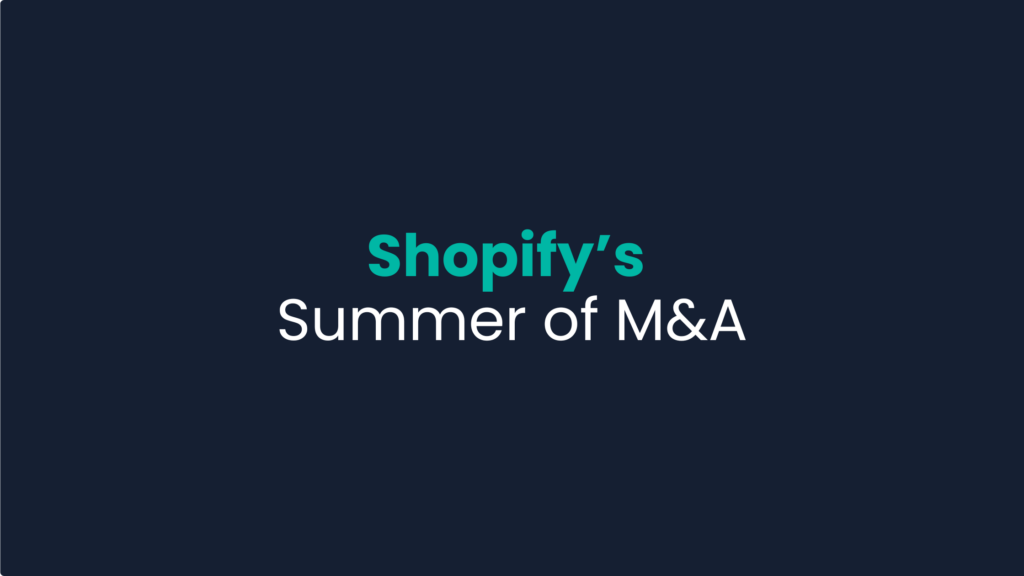Shopify’s 20-Year Shift to Enterprise
For the long run-up from their founding in 2004 to the pandemic, Shopify catered to mom and pop eCommerce brands building websites and selling products online. Shopify grew nicely over those years: by 2019 they had ~$650m in annual recurring revenue. Their flat-fee pricing and friendly public relations positioned them as a software company “on the side” of small eCommerce stores by making it easy for anyone to sell something without taking a percentage of that revenue. They also had a compelling founding story of CEO Tobi Lütke. He built Shopify because he tried to build an online snowboard shop and didn’t have any of the right tools, so he made them.
Shopify accelerated with the arrival of the COVID-19 pandemic in 2020. As the world shifted towards e-commerce, Shopify emerged as one of the biggest beneficiaries. SaaS companies like Shopify saw their valuations soar, driven by historically low interest rates and the belief that the surge in online shopping represented a permanent change in consumer behavior. The years 2020 and 2021 were the best on record for eCommerce. This was a great time for the leading eCommerce infrastructure provider.
But the post-pandemic landscape has not been as kind to Shopify and the eCommerce industry. Many of the high-flying DTC brands that had flourished have now fallen on hard times – declaring bankruptcy, shutting down, or being acquired for a fraction of their former value as they struggle to maintain profitability, as the initial COVID-driven boom has subsided. Shopify’s stock price has mirrored this broader industry downturn.
Shopify continues to evolve, even as the world faces challenges. While I don’t have insider information, it seems Shopify is focusing on two key areas of e-commerce: large brands and omnichannel experiences. Shopify likely prioritizes large brands because they provide more reliable and substantial revenue streams. Large brands typically pay more, require more features (leading to more upsells), and have lower churn rates compared to smaller customers. Additionally, Shopify’s focus on omnichannel experiences aligns with the broader trend towards integrated online and offline commerce. This is likely driven by the fact that large, established brands are more likely to have an omnichannel presence, as well as the recognition that omnichannel is the future of the industry.
Shopify’s M&A and venture capital activity has been plentiful over the years, but their activity has supported this narrative just in the past few months. Here are a few examples.
Recent M&A Activity
Checkout Blocks. Shopify purchased Checkout Blocks in June 2024. It is a Shopify app that helps brands build and customize their checkout experience. Checkout Blocks enables merchants to customize their checkout experience by adding features like AI recommendations, custom content, custom fields, discounts, email validation, and personalized order pages. It is also a no code platform so business users can make edits without having to hire a developer. This is all in service of making a higher-converting checkout — little tweaks like asking for an email address, dynamically updating shipping prices, or suggesting similar products can make a large impact on both immediate and long-term revenue.
This acquisition was in direct service of supporting continued Shopify Plus growth, as shown by a couple of data points. First, in February, the CEO of Checkout Blocks Gil Greenberg posted that they had surpassed 850 Shopify Plus brands. Checkout Blocks was built exclusively for Shopify Plus, indicating a priority for them to build products for the enterprise customer segment. Second, after the acquisition, Shopify made Checkout Blocks free for Shopify Plus brands. Part of that is certainly connected with their upcoming sunsetting of checkout.liquid, a Shopify checkout layout template, and launch of Checkout Extensibility, their new in-house checkout product. Greenberg’s LinkedIn indicates that he’s now the Product Lead on this checkout product.
ChannelApe. Shopify purchased ChannelApe in July 2024. ChannelApe’s story might have a different journey than Checkout Blocks, but a similar ending. ChannelApe is a software platform that helps brands manage their inventory (inventory tracking, order management, etc.). When a customer places an order on a brand’s online store, ChannelApe’s software quickly analyzes the available inventory across the brand’s warehouses. It identifies the warehouse location that has the ordered item in stock and is closest to the customer’s delivery address. ChannelApe then automatically selects the shipping carrier that can get the item to the customer the fastest, at the lowest cost, and allows the brand to track the entire process. According to PitchBook, ChannelApe has raised a few rounds of capital, most recently a $7m Series A in 2021.
It’s unclear how well ChannelApe was doing at the time of acquisition. According to the press release, they won’t be accepting any new customers now that they’ve been acquired. They had 17 employees on LinkedIn when they were bought. But the acquisition does seem to align with Shopify’s goals. Complex inventory management is something larger, omnichannel brands need more than small brands do, and that’s exactly what ChannelApe’s software does. Even if Shopify shuts down the product, it will still be a win to have a talented team working on Shopify’s order management product.
Threads. Threads was a Slack-like business communication platform, and Shopify purchased them in July 2024. The story here isn’t so much about buying a product or customer base and more about acquiring a great team. From most accounts Threads didn’t work as a product. It only had a few mobile downloads (until it was downloaded over 800k times by accident when another Threads – Meta’s X competitor – launched) and when it was acquired the company was shut down. After Meta’s Threads launched, buyers reached out to the independent Threads to buy the domain (or the whole company). They decided to sell to Shopify, in short because of Shopify’s entrepreneurial culture. Shopify is founder-led and well-known to be the home of many former founders. It’s a great landing spot for high quality talent who need a new home.
What’s next for Shopify?
Shopify’s recent acquisition activity suggests they will continue to pursue two key strategies going forward. First, Shopify appears likely to continue acquiring smaller companies that have talented teams, even if their core products are struggling. The Threads acquisition is a prime example – Shopify was more interested in bringing on the engineering talent than the product itself. This “acquihire” approach allows Shopify to quickly add experienced personnel to their ranks and integrate them into the company’s entrepreneurial culture.
Secondly, Shopify will probably focus on acquiring companies that enhance their Shopify Plus offering for larger enterprise customers. The Checkout Blocks and ChannelApe acquisitions demonstrate Shopify’s plan to build out more robust, customizable features for their higher-value Shopify Plus clients. As Shopify prioritizes serving larger brands with omnichannel needs, we can expect them to continue making strategic acquisitions that improve the functionality and value proposition of Shopify Plus.
Beyond these two core strategies, Shopify may also explore acquisitions that expand their ecosystem in adjacent areas. For example, Shopify has been growing their payments business quite nicely over the years (leading to an increased margin profile) and additional M&A that helps payments adoption isn’t out of the question. Shopify’s strong cash position and stock as acquisition currency give them significant flexibility to continue growing through M&A in the years ahead.
verall, Shopify appears poised to leverage acquisitions to both strengthen their core platform and bring on top talent, as they navigate the ever evolving eCommerce landscape.

